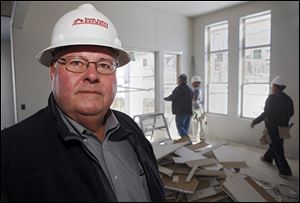
Manpower shortfall slows building surge
5/12/2013
Richard Vap, owner of South Valley Drywall, poses for a photo at a home construction site with one of his crews working in the background in Lakewood, Colo.
The resurgent U.S. housing market has sent builders calling again for Richard Vap, who owns a drywall installation company. Mr. Vap would love to help — if he could hire enough qualified people.
“There is a shortage of manpower,” said Mr. Vap, owner of South Valley Drywall in Littleton, Colo.
“We’re probably only hiring about 75 or 80 percent of what we actually need,” he said.
U.S. builders and the subcontractors they depend on are struggling to hire fast enough to meet rising demand for new homes. Builders would be starting work on more homes — and contributing more to the economy — if they could fill more job openings.
In the meantime, workers in the right locations with the right skills are commanding higher pay.
The shortage of labor ranges across occupations — from construction superintendents and purchasing agents to painters, cabinet makers, and drywall installers. The National Association of Home Builders said its members have complained of too few framers, roofers, plumbers, and carpenters.
The shortage is most acute in areas where demand for new homes has recovered fastest, notably in Arizona, California, Texas, Colorado, and Florida.
The problem results largely from an exodus of workers from the industry after the housing bubble burst. Experienced construction workers lost jobs.
And many found new work — in commercial building or in booming and sometimes higher-paying industries such as mining and natural gas drilling — and aren’t eager to come back.
Dave Erickson, president of Greyhawk Homes in Columbus, Ga., lost an employee who took a job this year in Texas. The former employee is now installing fiber-optic cable and earning 30 percent more than he did as a construction supervisor.
“I think he’s frustrated with the cycle we went through in recent years,” Mr. Erickson said.
A shortage of labor in a well-paying industry might seem incongruous in an economy stuck with a still-high 7.5 percent unemployment rate. But it reflects just how many former skilled construction workers have moved on to other fields.
In 2006, when the boom peaked, 3.4 million people worked in homebuilding. By 2011, the figure had bottomed at about 2 million. As of last month, about 2.1 million people were employed in residential construction.
Jobs in the industry did rise 4.1 percent in April from a year earlier, faster than overall U.S. job growth. But they’d have to surge 24 percent more to reach 2.6 million, their 2002 level — “the last time the market was normal,” said David Crowe, chief economist for the National Association of Home Builders.
For now, the industry is building faster than it’s hiring. In February, builders began work on single-family homes at the fastest pace in five years.
And in March, new-home construction broke the 1 million mark for the first time since June, 2008. Permits for future construction are also near a five-year high.
In the 12 months that ended in March, housing starts surged 47 percent. Yet over the same period, the industry’s employment grew just 3.7 percent.
Normally, a rebound in home construction helps propel an economy after a recession. But even with the steady gains in housing starts, sales, and prices since last year, the industry remains below levels considered healthy.
The National Association of Home Builders says nearly half its members who responded to a survey in March said a scarcity of labor has led to delays in completing work. Fifteen percent have had to turn down some projects.
“I can’t find qualified people to fill the positions that I have open,” says Vishaal Gupta, president of Park Square Homes in Orlando, Fla. If not for the labor shortage, “I would be able to build more homes this year and meet more demand than I can handle today.”
Mr. Gupta’s company is facing a side effect of the labor shortage: Demand for higher pay from qualified workers. On some occasions, he said he’s been outbid by rivals that need contractors for their own projects. Mr. Gupta’s preferred paint contractor left for a rival that paid more. His new cabinet contractor is about 10 percent more expensive than the one Mr. Gupta used before.
The higher pay they’re handing out helps explain why builders have been gradually raising prices on new homes.
The median price was $247,000 in March, up about 12 percent from the same month in 2011, according to the Commerce Department.
The industry may have to look more aggressively for workers at vocational schools, federally funded programs such as Job Corps and elsewhere, saids Mr. Crowe of the homebuilders group.
“We’ll have to recruit more,” he said.